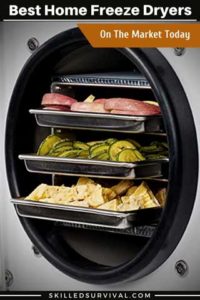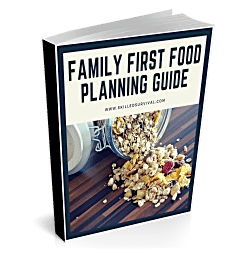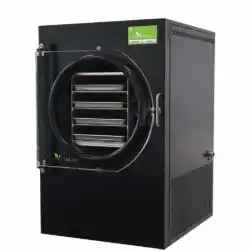
A Complete Guide On Buying & Using A Home Freeze Dryer
Because I believe, someday soon, every home will have a freeze dryer…
And food waste will become a thing of the past!
But why wait…
YOU can start freeze drying food today.
TOPICS IN THIS GUIDE… ↓(click to jump)
- What Is A Freeze Dryer Anyway?
- How Freeze Drying Works
- The Benefits Of Owning One
- The Downsides Of Owning One
- Best Freezer Dryer Features
- Best Freeze Dryers On The Market
- DIY Freeze Drying Machines?
- Best Foods To Freeze Dry At Home

Want a free family-first food planning guide?
Enter your email below to instantly download this Complete Guide PDF. No purchase necessary. 👇 👇What Is A Freeze Dryer?
A freeze dryer is an appliance that removes nearly all the moisture from food.
Removing moisture provides several benefits (which we’ll get into later).
But the primary benefit is an incredibly long shelf life.
And when it comes to food preservation shelf stable foods are essential.
Now let’s discuss HOW they work.
How Freeze Drying Works
Let’s first talk about how it doesn’t work!
Many people confuse freeze-drying with dehydration.
Why? Because they’re different forms of food preservation.
Both remove moisture from food.
But there are major differences.
First, let’s discuss dehydration.
Dehydration
Dehydrating food is simple.
Circulate hot, dry air across food on open racks.
This causes the water to evaporate and the food to shrivel.
The elevated temps remove moisture but doesn’t ‘cook’ the food.
But you may lose some of the vitamins and nutrients in this process.
Plus, the taste and texture changes dramatically.
Raisins, dates, and beef jerky are examples of dehydrated foods.
The Process of Freeze Drying
On the other hand, freeze-drying is a more complex.
It involves 3 steps:
- Freezing
- Lowering pressure
- Removing the moisture through sublimation
↓ How Freeze Drying Works
The end product is completely different than “dehydration”.
Because of this complexity, it takes high-tech equipment.
Like dehydrating, you place food on open racks.
But, you load the racks into a vacuum chamber.
Then the freeze dryer lowers the temperature inside the vacuum chamber.
An incredibly low temp (around -40deg F).
Once the food is completely frozen, a vacuum pump lowers the pressure.
And then the temperature slowly raised back to normal.
Due to the reduced pressure, the water in the food “sublimes.”
Sublimation is when solid ice changes directly into water vapor.
The food gives up its water content without sacrificing texture, flavor, or nutrition.
The bottom line:
I’ve seen someone rehydrate an entire lasagna on a backpacking trip.
↓ Home Freeze Dried Food: Appearance, Taste & Nutrition

Want a free family-first food planning guide?
Enter your email below to instantly download this Complete Guide PDF. No purchase necessary. 👇 👇The Benefits Of Freeze-Drying Food
So, why choose it over dehydrating if it’s more complex?
More Moisture Removal
All living organisms need moisture to live.
So removing it prevents the spread of mold and bacteria.
Lower the water content enough and it’s nearly impossible for them to survive.
- Most home dehydrators can remove 90 to 95 percent of water.
- By comparison, freeze-drying removes up to 99 percent.
The bottom line:
Freeze-drying removes more moisture.
Thus creates a better shelf life.
That’s why it’s considered one of the best non-perishable foods.
Freeze-dried meals properly sealed in Mylar bags will keep their:
- texture
- flavor
- and nutritional value for up to 25 years (or longer)!
Better Nutritional Content
Dehydrating doesn’t change the fiber or iron content.
But many vitamins and minerals break down at higher temps.
Freeze-dried foods keep more of these valuable vitamins and minerals.
More Appealing Appearance & Composition
The biggest hurdle for dehydrated food is taste and texture.
Freeze-dried foods keep the shape and color of fresh food.
Rehydrating the food back to a similar original consistency!
For example:
Freeze-dried strawberries become soft again.
Just add a little water or place them in your mouth.
Lower Weight
The greater reduction in water provides a reduction in weight.
This is great for backpacking and every ounce counts!
Less Cooking Time & Effort
Freeze-dried foods only need water to reconstitute them.
Unlike the slow simmer, you have to do with dehydrated foods.
Most freeze-dried foods will be ready to eat in 5 minutes.
This makes meal prep fast.
The Disadvantages Of Freeze-Drying Food
Of course, there are some drawbacks to freeze-drying foods.
Higher Price
Honestly, this IS the biggest factor for most.
But it’s a shame…
I get it; a food dehydrator can come in at under $50.
Heck, they often show up at Goodwill.
By comparison, a small model freeze dryer costs more like $2000!
And on top of that, all freeze drying machines use a lot of electricity.
If you run it full-time during the late summer (when fresh produce is rolling in), energy costs can add up.
↓ How Much Electricity Does A Freeze Dryer Use?
But here are three ideas to make the cost more palatable.
1. Get a group of friends to “co-own”.
You could become a part-owner with friends!
Then share the freeze dryer for different parts of the year.
If you find 4 other “investors,” you all could own a $2000 freeze dryer for $500.
More reasonable on a tight budget.
2. Start a small business
Consider starting a small business adventure!
- You can loan the unit to others…
- Or take other people’s foods and freeze-dry them.
- Or sell freeze-dried meals yourself.
Customers could start as friends, then neighbors.
After that, go to farmers’ markets or even online sales.
3. They’ll pay for themselves over time.
Another way to justify the expense is a cost comparison over time…
With $2900, you can get about 295,000 calories worth of store-bought freeze-dried food.
For a typical family of four (1500 calories per person per day), that’s only about 1.5 months’ worth of emergency food.
On the other hand, with a home freeze dryer, you can freeze and store all your leftover or bulk discount food purchases or extra
THIS year, NEXT year, and on and on.
So if you use your dryer ALL the time, you can save money over time.
↓ Harvest Right Freeze Dryer Vs. Store-bought Freeze Dried Food
Fixed Process Volume
I’ve expanded my old dehydrator 4 times.
It now has more drying racks than it did when I bought it.
This has given me a huge increase in the volume of food I can preserve.
Volume expansion is not as easy with a freeze-dryer.
This is because the food has to fit in a smaller vacuum chamber.
And each run can take days to finish.

Want a free 78 item prepper checklist?
Enter your email below to instantly download this Complete Checklist PDF. No purchase necessary. 👇 👇Best Freeze Dryer Features To Look For
Perhaps you still have some key questions before investing:
↓ Watch This BEFORE You Get A Freeze Dryer!
How much food do you need to preserve?
Most freeze dryers give stats on:
- the size of the vacuum chamber
- and the amount of food that can fit in one batch
If you plan on smaller batches (i.e., you’re only “cooking” for yourself and a partner), you can get away with a smaller dryer.
For a crowd, you’ll likely need a larger dryer.
How much space do you have for a large appliance?
These machines take up a lot of space.
Plus, the vacuum chamber, the control system, and the pumps add to the footprint.
Some smaller ones can fit on a countertop/
But the large ones are the size of a dishwasher.
How much electricity do they consume?
The large pump and other machinery involved in freeze drying can take serious power.
You may need a dedicated electrical circuit for larger models.
What maintenance are you willing to do?
Most home freeze dryers are fairly easy to maintain.
But they do need cleaning and inspection from time to time.
As well as the door seals and other critical parts.
Also, some models come with a vacuum pump that requires oil changes.
Some allow for an upgrade to an oil-free pump, but it comes at a premium.
↓ Freeze Drying 101: Understanding The Cost Of Using A Freeze Dryer

Want a free family-first food planning guide?
Enter your email below to instantly download this Complete Guide PDF. No purchase necessary. 👇 👇Best Home Freeze Dryers For Sale Today
When it comes to freeze drying appliances, there’s only one name on the market – Harvest Right.
Other manufacturers make solid, well-built freeze-drying machines.
But these units are for the industrial market.
These commercial units occasionally come up for sale.
And a used commercial freeze dryer can be a GREAT deal ID you find the right one.
For the rest of us, there are three models from Harvest Right (small, medium, and large).
All three units are essentially the same except for their dimensions and price.
But all three sizes have several color options to choose from, to help match any kitchen décor.
The Small Harvest Right Freeze Dryer is ideal for someone just getting into at-home freeze drying.
It can freeze dry anywhere from 4-7 LBS of fresh food per batch, translating into about 840 LBS of fresh food annually!
The size of the Small Harvest Right Freeze Dryer is 25 inches tall, 16.5 inches wide, and 18.5" deep.
If you're hoping to buy a freeze dryer that can fit on a kitchen countertop, this is the only unit I know of that can do it.
But even then, it is still a fairly large appliance for a countertop. Be aware of your headspace and depth to ensure it will fit - if this is your goal.
The Medium Harvest Right Model can take up to 7 to 10 lbs of fresh food per batch.
This is a decent amount of volume while not requiring the dedicated circuit that the Large unit may need.
The dimensions of the medium unit are 28.5 inches tall, 18 inches wide, and 21.25 inches deep.
It's a good compromise on price, size, and capacity.
↓ Harvest Right Medium Freeze Dryer Review
Finally, Harvest Right makes a large at-home freeze dryer.
This larger unit can freeze dry up to 16 LBS of fresh food per batch.
This helps to drastically cut down on the number of batches you need to run!
However, this unit needs quite a bit of floor space. Its dimensions are 30.75 inches tall, 20.25 inches wide, and 23.75 inches deep.
So if you're looking to invest in a home freeze dryer to start a small business venture, this is the best unit for you.
These are the 3 main freeze-dryer choices for at-home freeze-drying…
I hope the market grows in the next few years .
I’d love to see new features and innovation and a price drops.
But until then, the handy and frugal DIYer can always build their own!
How To Build A Freeze Dryer
Yes, building your own DIY Freeze Dryer is possible.
But it’s also challenging.
This is not a project for newbie DIYers.
And you’re not likely to match the same high quality as commercial versions.
But you can’t beat the price…
Here’s an excellent DIY build (if you’re up for the challenge):
↓ How To Build A Freeze Dryer

Want a free 78 item prepper checklist?
Enter your email below to instantly download this Complete Checklist PDF. No purchase necessary. 👇 👇Best Foods To Freeze Dry
While the manufacturers state nearly any food can be freeze-dried, that’s not quite accurate.
Many foods freeze dry very well.
But some need more pre-processing first.
Here’s a video that provides a nice overview:
↓ How To Freeze Dry At Home Overview
Now that you have an overview, here are some more freeze-dry preparation details:
Fruits and Veggies
Small fruits and vegetables (blueberries, beans, etc.) can be freeze-dried in one piece.
But you’ll need to cut larger items into smaller slices or chunks.
I’ve heard that freeze-dried watermelon is fun.
With the look and taste of watermelon but the crunch and weight of rice cakes!
Meats
This same principle also applies to meats.
Stewed meats freeze dry well.
But large thick steaks are more challenging.
Cook all meats before drying.
The rehydration process might not involve adequate heat to cook it later.
Coffee
How did you think they filled those packets of instant coffee crystals?
Meat
Not jerky, but superlight chunks of steak ready to be added to dinner in a flash!
Fish and Seafood
Freeze-dried shrimp feels like they should be fake.
But they rehydrate well for soups and burritos!
Eggs
Real scrambled eggs on day 9 of a trip?
You can do that with freeze-dried egg powder.
That’s a treat.
Dairy
Dried milk powder is a staple in some places.
This makes it possible to keep a large amount of milk on hand without it spoiling.
Freeze-dried butter powder is an amazing find,
It has improved the quality of my camping meals!
Final Thoughts
Freeze-drying at home is a great way to add long-term shelf life to emergency supplies.
I consider it an advanced prepping tool.
But the taste, texture, and nutritional improvements go a long way to enjoying foods for the long term!
No matter what the future holds…
Why Trust Skilled Survival...
Go here now to review a full breakdown of:
- Who We Are
- Our Credentials
- Our Mission
- & Product Recommendations...
Here are a few highlights of our teams credentials & certifications:
- Certified Member of a Mountain Search & Rescue Organization
- Plant Emergency & Safety Leader for a Major Food Manufacturer
- Member of the 10TH Mountain Division Hut Association
- Certifications: Avalanche 1, WFR, CPR
- Official Gear Tester for Numerous Outdoor Gear Companies
- Countless Multiday Backpacking trips into Remote Wilderness
- Bachelor's Degree In Mechanical Engineering
- Bachelor's Degree In Civil Engineering
- Bachelor's Degree In Biomedical Engineering
"It takes 20 years to build a reputation and five minutes to ruin it." - Warren Buffett
We're fully aware that trust is NOT something you GET but is EARNED.
And we'll continue to earn YOUR trust through our forthright and honest approach with each new Blog Post, Guide & Product we create...
Prepare, Adapt & Overcome,


AND... I've still got a few gaps in my preps...🤔 But at least, I'm not part of 'The Fragile Masses'. 👍 Find out where YOU stand by answering a few questions...

Recommended Reading
Emergency Food Storage When Calories Become Scarce
Building your emergency food storage doesn't have to be complicated. We break things down into simple steps to help you do it right.
The Most Nutritious Survival Foods You’ll Actually Love
What are the best survival foods? It depends on your goals. We look at different scenarios to help you stockpile the best emergency foods.
Dehydrating Fruit: How To Preserve Sweet Calories
Dehydrating fruit is a great way to store tasty calories for long-term storage. We should you the best way to dehydrate some for emergencies.
Best Fuel Storage Ideas: How To Store Extra Gasoline
Long term fuel storage is crucial in all survival situations, but fuels must be stored properly and safely to keep, especially long term gasoline storage.
How To Store Seeds For Wise Prepping & Survival
When seed saving and seed storage, you must do it right. Learn how to store seeds so they'll thrive the next planting season.
Common Everyday Carry Mistakes YOU Must Avoid At All Costs
The only person qualified to build YOUR Best Everyday Carry (EDC) is YOU. To do it right, you must avoid these common mistakes and pitfalls.


